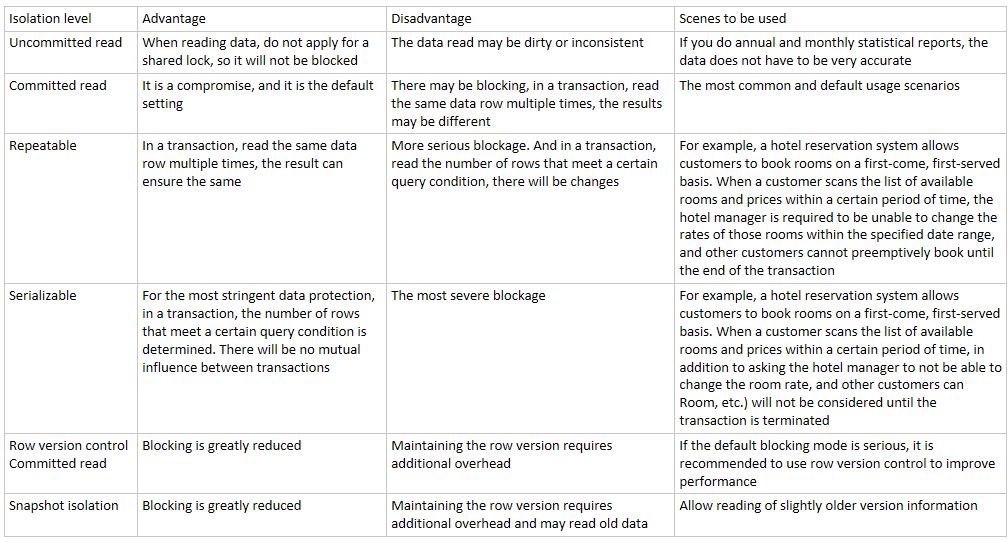Hi @Sam ,
What is the difference between "read_committed_snapshot" and "snapshot_isolation" when it comes to version store behavior ...?
Quote from this doc. : readcommittedsnapshot-and-snapshotisolation-levels-in-sql-server
To sum up, both the SNAPSHOT and the READ COMMITTED isolation levels (with READ_COMMITTED_SNAPSHOT is ON) use row versioning to manage isolation degree in transactions. While the SNAPSHOT isolation level protects from all phenomena, READ COMMITTED isolation level with enabled READ_COMMITTED_SNAPSHOT option prevents only dirty reads. Whereas the SNAPSHOT is a transaction isolation level, the READ_COMMITTED_SNAPSHOT is just a database option that can change the behavior of the READ COMMITTED isolation level in preventing dirty reads.
or do I have to turn on both for enabling row versions in tempdb to reduce blocking?
It depends on what kind of data you want to see, or your tolerance for the accuracy of the data.
Row version control is not a panacea to eliminate blocking and deadlocks. Before deciding to use it, the following two questions must be considered.
- Whether the end user accepts the running result under the line version control
In different transaction stages, some are blocked, some read the old version value, and some can read the new version value. What behavior do you or your users expect? Do you want to read the latest version of the data even if it is blocked, or can you tolerate reading the old version? Some applications rely on the locking and blocking behavior of read isolation, such as operations such as generating a serial number. Change to version control, and the original processing logic will not work properly. So before adopting the new isolation level, be sure to do a good job of testing to ensure that the application will run as expected.
- Can SQL Server support the additional load caused by row version control
When row version control is enabled, SQL Server will store the row version in tempdb. The more data is modified and the more information needs to be stored, the greater the additional load on SQL Server. Therefore, if an application is to switch from other isolation levels to version control, special testing is required to ensure that the existing software and hardware configuration can support the additional load and the application can achieve a similar response speed.
The following is for reference only, I hope it will help you:

How can we track down the spids, queries , size of version store for that particular spid which using up the version store?
The space usage of tempdb cannot be tracked with sp_spaceused,can use the management view sys.dm_db_file_space_usage.
The next codes may be helpful:
use tempdb
-- View tempdb usage from the file level
dbcc showfilestats
-- Query 1
-- Return all session information that has made a space application
Select 'Tempdb' as DB, getdate() as Time,
SUM (user_object_reserved_page_count)*8 as user_objects_kb,
SUM (internal_object_reserved_page_count)*8 as internal_objects_kb,
SUM (version_store_reserved_page_count)*8 as version_store_kb,
SUM (unallocated_extent_page_count)*8 as freespace_kb
From sys.dm_db_file_space_usage
Where database_id = 2
-- Query 2
--This management view can reflect the overall allocation of tempdb space at the time
SELECT t1.session_id,
t1.internal_objects_alloc_page_count, t1.user_objects_alloc_page_count,
t1.internal_objects_dealloc_page_count , t1.user_objects_dealloc_page_count,
t3.*
from sys.dm_db_session_space_usage t1 ,
sys.dm_exec_sessions as t3
where
t1.session_id = t3.session_id
and (t1.internal_objects_alloc_page_count>0
or t1.user_objects_alloc_page_count >0
or t1.internal_objects_dealloc_page_count>0
or t1.user_objects_dealloc_page_count>0)
-- Query 3
-- Return the running statement of the session that is running and has made a space request
SELECT t1.session_id,
st.text
from sys.dm_db_session_space_usage as t1,
sys.dm_exec_requests as t4
CROSS APPLY sys.dm_exec_sql_text(t4.sql_handle) AS st
where t1.session_id = t4.session_id
and t1.session_id >50
and (t1.internal_objects_alloc_page_count>0
or t1.user_objects_alloc_page_count >0
or t1.internal_objects_dealloc_page_count>0
or t1.user_objects_dealloc_page_count>0)
More information: my-version-store-is-huge.html
BR,
Mia
If the answer is helpful, please click "Accept Answer" and upvote it.

